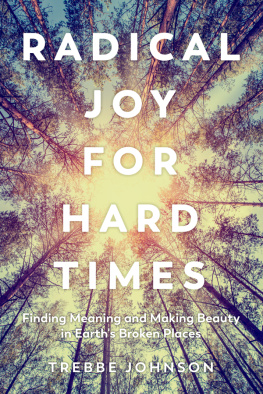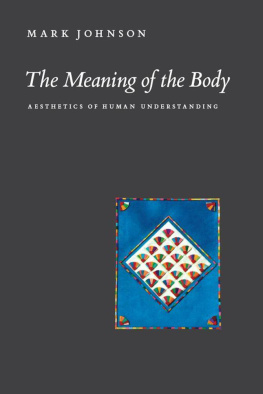
Praise for Radical Joy for Hard Times
In hard times there is a temptation to let the problems of the world orient the direction of our lives and the shape of our activism. Through her extensive artistic activist practice, Trebbe Johnson shows us a different path: a way to turn devastation into creation. Through simple acts of beauty, she provides a map that moves us from wallowing in dystopian despair to imagining utopian joy.
Stephen Duncombe, author of Dream: Progressive Politics in an Age of Fantasy and cofounder of the Center for Artistic Activism
How are we to face the ecological desecration of so many beloved places? Here at last is an ecopsychological guide bringing together many wise voices to show us a path beyond hopelessness into strength and renewal.
Craig Chalquist, editor of Rebearths: Conversations with a World Ensouled
There are some people on Earth who have a radical capacity for empathy. Trebbe Johnson is one of those people and she has applied her radical empathy to the appreciation of damaged places and the need for those places to receive the gift of healing beauty. Despite this Herculean task in a wounded world, she persists and refuses to ignore the desolation and look away. Radical Joy for Hard Times is Johnsons literary gift to the reader who wants to play a part in a global community of Earth healing. Accept it, its yours, given with love.
Glenn Albrecht, creator of the concept of solastalgia and author of Earth Emotions
Copyright 2018 by Trebbe Johnson. All rights reserved. No portion of this book, except for brief review, may be reproduced, stored in a retrieval system, or transmitted in any form or by any meanselectronic, mechanical, photocopying, recording, or otherwisewithout the written permission of the publisher. For information contact North Atlantic Books.
Published by
North Atlantic Books
Berkeley, California 94712
Cover photo gettyimages/scyther5
Cover design by John Yates
Book design by Happenstance Type-O-Rama
Printed in the United States of America
Grateful acknowledgment is made to the following to reprint previously published material:
Denis Dutton, 2009, The Art Instinct, Bloomsbury Press, an imprint of Bloomsbury Publishing, Inc.
Anonymous, trans. Barbara Hughes Fowler, from Love Lyrics of Ancient Egypt, 1994, University of North Carolina Press.
Parts of this book were previously published in Orion, The Ecologist, Ecopsychology, Spirituality and Health, Parabola, and the newsletter of the Parliament of the Worlds Religions.
Radical Joy for Hard Times: Finding Meaning and Making Beauty in Earths Broken Places is sponsored and published by the Society for the Study of Native Arts and Sciences (dba North Atlantic Books), an educational nonprofit based in Berkeley, California, that collaborates with partners to develop cross-cultural perspectives, nurture holistic views of art, science, the humanities, and healing, and seed personal and global transformation by publishing work on the relationship of body, spirit, and nature.
North Atlantic Books publications are available through most bookstores. For further information, visit our website at www.northatlanticbooks.com or call 800-733-3000.
Library of Congress Cataloguing-in-Publication data.
Names: Johnson, Trebbe, 1948- author.
Title: Radical joy for hard times : finding meaning and making beauty in
earths broken places / Trebbe Johnson.
Description: Berkeley : North Atlantic Books, 2018.
Identifiers: LCCN 2018031616 (print) | LCCN 2018033126 (ebook) | ISBN
9781623172640 (E-book) | ISBN 9781623172633 (paperback)
Subjects: LCSH: Motivation (Psychology) | Inspiration. | Self-actualization
(Psychology) | Environmental protection. | BISAC: NATURE / Environmental
Conservation & Protection. | SELF-HELP / Motivational & Inspirational. |
BODY, MIND & SPIRIT / Inspiration & Personal Growth.
Classification: LCC BF503 (ebook) | LCC BF503 .J64 2018 (print) | DDC
153.1/534dc23
LC record available at https://lccn.loc.gov/2018031616
North Atlantic Books is committed to the protection of our environment. We partner with FSC-certified printers using soy-based inks and print on recycled paper whenever possible..
For David Powless,
who planted the seed when he told me,
The waste is an orphan from the circle of life.
Foreword
It has been said many times that before you can heal a wound or solve a problem, you must first acknowledge that it exists. Too often, the many ways that our highly technological society is harming the Earth are not acknowledged. And even when they are, many among us fail to respond with the passionate action that is needed if we are to save the Earth and ourselves. Tragically, the same ideology that has allowed the destruction of the Earth to continue has also habituated us to turn away when we see a forest, decimated by strip-mining or logging; a lake, once beautiful, polluted with chemicals; a beach covered with plastic waste. Rather than see nature as companion and kin, we have been taught to treat the Earth as full of resources that we can take at will, as we want or need, including the need for recreation. When they do not give us pleasure any more, we are tempted to turn away from damaged places.
Yet the only way each of us can truly grasp the extent of the harm being done is to spend time in the places that have been harmed. Being there with others of like mind yields, through empathy, a deeper knowledge of the devastation that has occurred. But along with sorrow, Trebbes work restores our kinship with damaged places in the natural world through beauty, the beauty we learn to see, and the beauty we bring. In this way, we regain a profound intimacy with a powerful ally.
Such is Trebbe Johnsons great work in our world. This is the story of how and why it was created.
Susan Griffin, author of Woman and Nature: The Roaring Inside Her
Prologue
What Can You Do for a Sad Gray Place?
The places we love are under assault and there seems no way to cope with the loss.
You know the ones I mean. Those places that were as much a part of you as your family and your own private thoughts. Where you could lose yourself and find yourself at the same time. The places that had the power to enchant you every time you, like a lover, entered their mystery. You may think youve accepted their disappearance, convinced yourself of the inevitability of progress, and gotten over the loss, but theyre still there, abiding in you, though you can no longer visit them. They linger, laden with emotion, in your memory. They hover like ghosts right there in the world where they used to be, even though other things have taken their place. Theyre there behind the beauty strip, that neat scrim of tall pines left on the highway to fool you into thinking that a forest, rather than a wasteland of clear-cutting, extends back over the hills. Theyre those scars you can almost see ripping through the sky where the tops of the Appalachian Mountains have been flattened for coal mining. Theyre the dirge in the waves that still lap at the beaches where you can no longer take your children because toxic waste fouls the water. Memories of your moments in those places grab your heart when you consider the dead river, the smudged horizon, the dying hemlock and pion trees, the meadow paved for a mall, the silence over the roses that honeybees no longer visit, the twilight sky drained of bats. The dark side of nature seeps into your memory and imagination and reminds you not just of what the place used to be, but what you, too, used to be when it was part of you.
Next page









